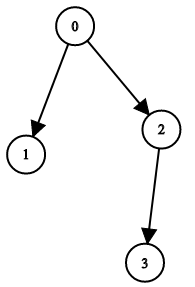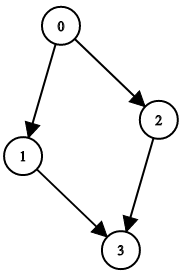[LeetCode] 1361. Validate Binary Tree Nodes 驗證二叉樹
You have n binary tree nodes numbered from 0 to n - 1 where node i has two children leftChild[i] and rightChild[i], return true if and only if all the given nodes form exactly one valid binary tree.
If node i has no left child then leftChild[i] will equal -1, similarly for the right child.
Note that the nodes have no values and that we only use the node numbers in this problem.
Example 1:

Input: n = 4, leftChild = [1,-1,3,-1], rightChild = [2,-1,-1,-1]
Output: true
Example 2:

Input: n = 4, leftChild = [1,-1,3,-1], rightChild = [2,3,-1,-1]
Output: false
Example 3:

Input: n = 2, leftChild = [1,0], rightChild = [-1,-1]
Output: false
Constraints:
n == leftChild.length == rightChild.length1 <= n <= 104-1 <= leftChild[i], rightChild[i] <= n - 1
這道題說是給了兩個數組 leftChild 和 rightChild,其中 leftChild[i] 表示結點i的左子結點,rightChild[i] 表示結點i的右子結點,若值為 -1,表示沒有左子結點或著右子結點,問給定的數組是否可以組成一個有效的二叉樹。對于二叉樹想必大家都不陌生,來看一下題目中給的例子,例子1是一棵有效的二叉樹,例子2中由于結點3有兩個父結點,所以不是有效的二叉樹,例子3中兩個結點互為父結點了,這也不是有效的二叉樹。二叉樹是一種特殊的有向圖,一棵有效的二叉樹至少要具備這個幾個特點,首先是只有一個根結點,即所有結點必須是連成一個整體的,其次是每個結點最多有兩個子結點,然后每個結點最多只有一個父結點,最后就是不能出現環。
有向圖有個入度 In Degree 的概念,就是某個結點被其他結點連通的個數,對于有效二叉樹來說,除了根結點之外的每個結點的入度必須是1,即每個結點最多只有一個父結點,根結點的入度是0,其沒有父結點。那這里就可以通過計算每個結點的入度,來快速去除一些無效的二叉樹,這里用個長度為n的入度數組 inDegree,然后遍歷兩個數組,若左子結點不為 -1,則將其入度值自增1,此時判斷一下,若入度值大于1了,說明是無效的二叉樹,返回 false,對右子結點進行相同的處理。
僅判斷結點的入度值是不夠的,比如例子3中,每個結點的入度都是1,但不是有效二叉樹,因為其沒有根結點,所以接下來需要找出根結點,而且只能有一個根結點,就是說只能有一個結點的入度是0,若找到了多個,則返回 false。找到了根結點后也還不能說就是有效的二叉函數了,還得保證所有的結點都是相連的,這個通過從根結點開始遍歷二叉樹,統計遍歷到的結點個數,若成功遍歷了n個結點,才能說是有效的二叉樹。遍歷的方法可以用 BFS 或者 DFS,這里先用 BFS,使用隊列 queue 來輔助運算,先把根結點 root 放進去,然后進行 while 循環,每次從 queue 中取出一個結點,計數器 cnt 自增1,然后看其左右子結點,若存在就加入到隊列中繼續循環,最后判斷 cnt 是否等于n即可,參見代碼如下:
解法一:
class Solution {
public:
bool validateBinaryTreeNodes(int n, vector<int>& leftChild, vector<int>& rightChild) {
int root = -1, cnt = 0;
vector<int> inDegree(n);
for (int i = 0; i < n; ++i) {
int left = leftChild[i], right = rightChild[i];
if (left != -1 && ++inDegree[left] > 1) return false;
if (right != -1 && ++inDegree[right] > 1) return false;
}
for (int i = 0; i < n; ++i) {
if (inDegree[i] != 0) continue;
if (root != -1) return false;
root = i;
}
if (root == -1) return false;
queue<int> q{{root}};
while (!q.empty()) {
auto t = q.front(); q.pop();
++cnt;
if (leftChild[t] != -1) q.push(leftChild[t]);
if (rightChild[t] != -1) q.push(rightChild[t]);
}
return cnt == n;
}
};
下面解法是用 DFS 來遍歷二叉樹,寫起來更加簡潔一些,在遞歸函數中首先判斷若當前結點 node 為 -1,說明不存在,則返回0,否則分別對其左右子結點調用遞歸函數,將返回值加起來,再加上1,就是以當前結點 node 為根結點的二叉樹的結點個數了,參見代碼如下:
解法二:
class Solution {
public:
bool validateBinaryTreeNodes(int n, vector<int>& leftChild, vector<int>& rightChild) {
int root = -1, cnt = 0;
vector<int> inDegree(n);
for (int i = 0; i < n; ++i) {
int left = leftChild[i], right = rightChild[i];
if (left != -1 && ++inDegree[left] > 1) return false;
if (right != -1 && ++inDegree[right] > 1) return false;
}
for (int i = 0; i < n; ++i) {
if (inDegree[i] != 0) continue;
if (root != -1) return false;
root = i;
}
if (root == -1) return false;
return countNodes(leftChild, rightChild, root) == n;
}
int countNodes(vector<int>& leftChild, vector<int>& rightChild, int node) {
if (node == -1) return 0;
return 1 + countNodes(leftChild, rightChild, leftChild[node]) + countNodes(leftChild, rightChild, rightChild[node]);
}
};
Github 同步地址:
https://github.com/grandyang/leetcode/issues/1361
參考資料:
https://leetcode.com/problems/validate-binary-tree-nodes/
https://leetcode.com/problems/validate-binary-tree-nodes/solutions/517557/c-find-root-dfs/






 浙公網安備 33010602011771號
浙公網安備 33010602011771號